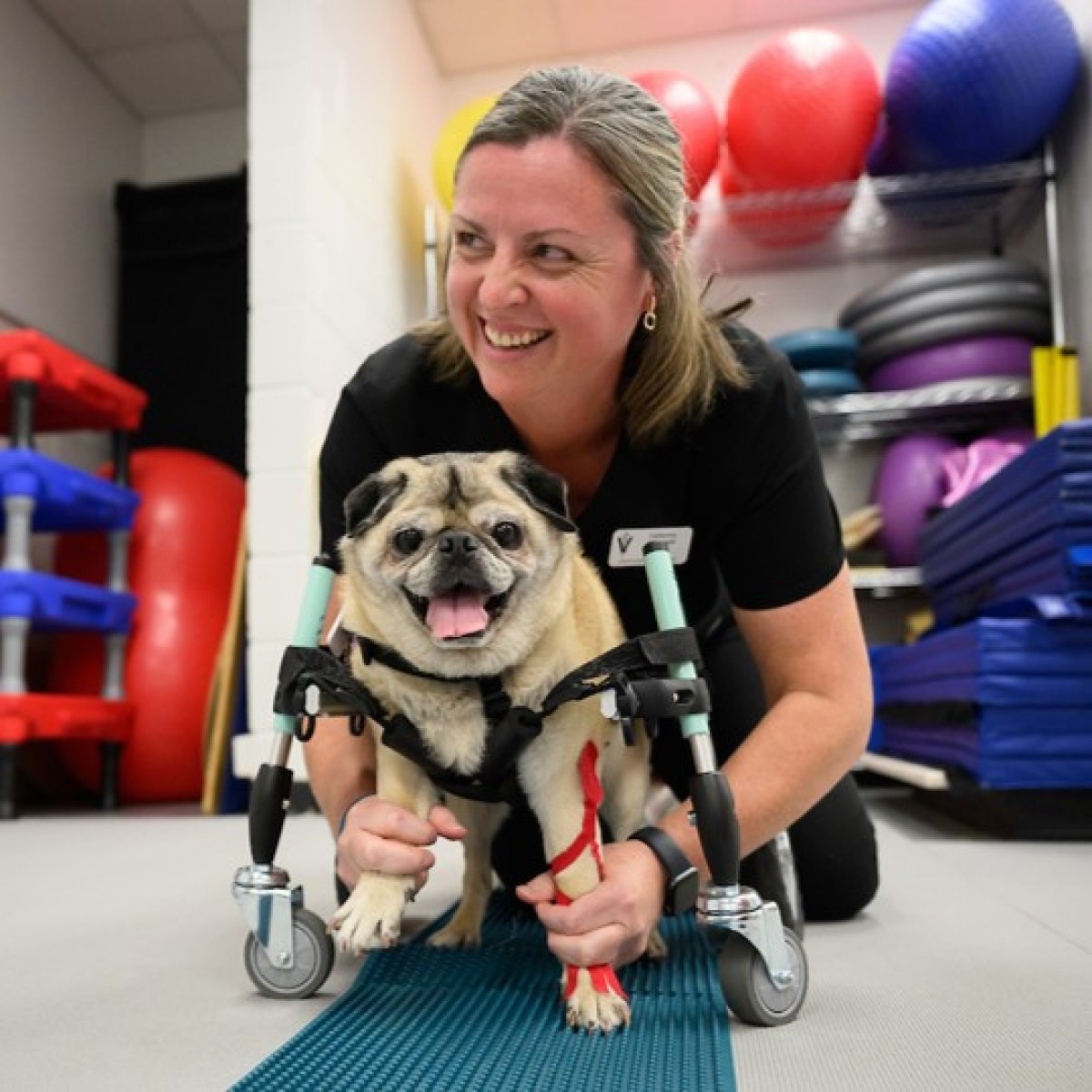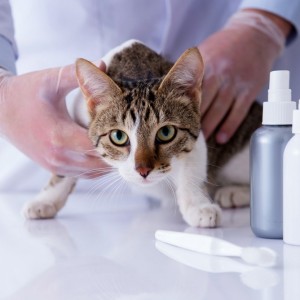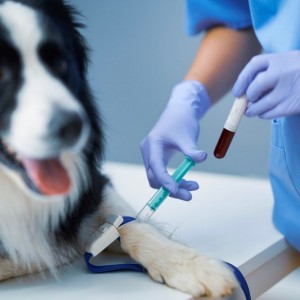‘He’s Got to Live!’ — The Case of WALL-E and the Power of Exploring Possibilities
Because of the strength in the dog’s hind legs, the spunk in his spirit and the loving interactions with his devoted companions, Dr. Kady Gjessing felt that end-of-life conversations about WALL-E, a deaf and nearly blind pug, might be premature.
Cara Smelter and Phillip MacDonald had brought their nearly immobile 16-year-old rescue baby to Gjessing, who leads NC State Omega Transitional Care, at the suggestion of a doctor who had treated WALL-E for pain in the NC State Veterinary Hospital’s emergency department.
“He came into the room, and there was just something about him,” Gjessing says. “I looked at that tail! I looked at the interaction he has with Phillip and Cara! There was no way this dog was ready to stop.”
Since that initial assessment about 10 weeks ago, WALL-E has become the poster pup of possibilities, a joyful picture of what can happen when creative medical professionals putting expertise behind their “what ifs” work with dedicated dog guardians to prolong a life of quality.
“As a teaching hospital, they can explore new things and see what can be done and not just write things off because they might not be easy or you haven’t done it before.” — Cara Smelter, WALL-E’s human companion
“This is the uniqueness of what the NC State vet school offers,” Smelter says. “It provides a space for inquiry and curiosity, to go outside what the normative could be. As a teaching hospital, they can explore new things and see what can be done and not just write things off because they might not be easy or you haven’t done it before.”
In 2020, Smelter and MacDonald, both North Carolina natives who live in Raleigh, fell in love with a picture of a goofy dog on a rescue website, took the old guy home and renamed him after a robot in a beloved 2008 Pixar movie.
“Because he was deaf, we knew we could change his name without confusing him and, in less than 24 hours of being with him, we named him WALL-E,” Smelter says. “He has those same big beautiful eyes full of curiosity and joy and just looks like the cutest little robot that is his namesake.”
As WALL-E grew older, he began exhibiting hind-leg weakness and, in June, had an episode of extreme pain and immobility, later ascribed to Intervertebral Disc Disease. When WALL-E had another episode two days later, the couple took him to the NC State Veterinary Hospital emergency room.
WALL-E is at the outer edge of life expectancy for even healthy members of his breed. When the couple decided to contact Omega, they fully trusted the NC State College of Veterinary Medicine to assess and suggest with WALL-E’s quality of life being the utmost concern.
“This is something we absolutely wanted to pursue, that was in perfect alignment with the situation we were working with,” says Smelter, a Charlotte native who has worked in the NC State University counseling office. “We know he is a senior, so this service could serve him no matter what. They do palliative care. We came into it with the understanding that this could be an end-of-life conversation.”
But Gjessing, a veterinarian with more than 30 years experience, watched WALL-E with a practiced eye and an open heart and said not yet.
“What he would do is he’d keep his legs out and also shoot up because his legs were so strong, and we were going, ‘How in the world is this dog doing this?’” says Gjessing, who helped launch the Omega service in April. “That’s when we knew: He’s got to live.”
A Plan Comes Together
Gjessing asked Smelter and MacDonald to give her a couple days to consider all of the data and to consult her colleagues — notably Catherine McDonald, a clinical veterinary technician specializing in sports medicine and rehabilitation — before she offered them a treatment plan for WALL-E.
“I love that so much,” says Smelter, who just completed a degree in mental health counseling at NC Central University. “She wasn’t trying to just spout out whatever comes off the top of your head. She made no promises, but she framed it really beautifully, saying maybe some of it will work, maybe some of it won’t, but we have a space to try now that we’re working together.”
The praise among team members after weeks of work is that McDonald is a miracle-worker, Gjessing is an angel and Smelter and MacDonald could win awards for being the most hands-on, dedicated pet companions ever.
Because of WALL-E’s deafness and poor eyesight, McDonald couldn’t use conventional voice commands in her therapy plan, so she had to find ways to involve his other senses in his recovery.
“That was kind of the first thing I told them,” she says. “If these senses aren’t working to their fullest, we’re going to use his nose as his superpower and treats.”
So many treats.
As a physical therapy expert, McDonald looks at how an animal’s body is functioning. Because of WALL-E’s hind-limb weakness and tendency to splay his front legs, she started with providing sensory input to his hind end and building up his strength while giving his companions exercises for the dog to do at home.
“We were retraining his brain to go from ‘This is all I can do’ to the next thing you do is you stand up,” she says. “So first he would go from lying down to standing up. And then we retrained him how to walk.”
McDonald also has employed textured mats to give WALL-E sensory input from his feet to his spinal cord, kinesiology tape wrapped on his legs to help him know where his limbs are in space and scent bags to keep his mind and interest engaged.
“It’s like magic what that K tape can do,” says MacDonald, who has a master’s degree in library science from UNC-Chapel Hill. “It’s wild how much better his legs stay right.”
For the scent bags, McDonald asked the couple to take rags to WALL-E’s favorite outdoor spots and collect a different scent in each bag to give the dog cognitive input during down times. Smelter says she’s lucky no one called the police on her.
“I was at a fire hydrant, inside a bush, a lamp post, and I was rubbing that pole getting all the pee smells,” she says. “But it was so nice. When he was on a bed, you could tell he was getting more excited, because he was like, ‘Oh, I can smell things. I can actually feel I’m somewhere else.’”
“I love my job because it is a lot of thinking outside the box. There isn’t a lot of literature that says, ‘This is what you do with this,’ and there’s always a curve ball.” — Catherine McDonald, a clinical veterinary technician specializing in sports medicine and rehabilitation
Willing to Give It a Shot
In mid-August, WALL-E had a relapse and again found it difficult to walk. Bed rest and a steroid were ordered, and a consulting neurologist said if the steroid didn’t help after a week it might be time for a different conversation.
This time, it was McDonald who said not yet. Having witnessed WALL-E’s amazing adaptability, she wondered whether getting him a cart, kind of like a walker for dogs, would help stabilize his front legs enough to get him mobile.
“Cara and Phillip were willing to give it a shot,” she says. “I wasn’t sure if it was going to work because I didn’t want him to run over his own feet, but they are the best owners. They were doing all the home exercises and helping with that sensory input, and he was bringing his legs further in.”
Unfortunately, the Walking Pets carts McDonald had in mind were on back order, but when Gjessing reached out to the manufacturer and explained WALL-E’s senior situation, Paw Prosper kindly found one to send.
“Because she’s an angel on earth, they actually expedited it,” Smelter says. “And when we saw him walking in that cart, we absolutely lost our mess. How could you not with that little chunky tail hanging off the back?”
Six weeks later, WALL-E is back to playfully wandering around, using the cart for support when he’s tired. The at-home physical therapy continues, now with yoga mats covering the floors of Smelter and MacDonald’s home to keep him from slipping. And McDonald still meets with him for therapy at NC State each week, eager to see his progress.
“I love my job because it is a lot of thinking outside the box,” McDonald says. “There isn’t a lot of literature that says, ‘This is what you do with this,’ and there’s always a curve ball. There are always multiple things going on that need to be considered when treating them. That’s what makes it so cool, because we have to ask ourselves, ‘What is the most important thing here?’”
For Smelter and MacDonald, NC State has been like a life preserver during a period that has sometimes gutted them, Smelter says.
“The cart very much gave us hope because it was about potential and what might possibly be,” she says. “And if it didn’t work out, at least we could say we tried it, we gave it a good go, we did what we could.”
As long as WALL-E has his spark, loves his treats and enjoys going for walks in a baby stroller, she and MacDonald are committed, she says. “He still has a lot to give.”
What WALL-E has already given Gjessing is a new appreciation for what can be accomplished with curiosity and individualized care. Every dog — and every owner’s circumstances — is different, she says, and every treatment plan should reflect that as well.
“I mean, he’s happy!” she says. “Does he have some neuro deficits? Yeah, but who cares? Nobody is perfect, for crying out loud. And the point is, he’s still having a quality of life, though I know we’re going to have to, at some point, say enough is enough.”
But not yet.
Author: Burgetta Eplin Wheeler
Source: https://news.cvm.ncsu.edu/













List
Add
Please enter a comment